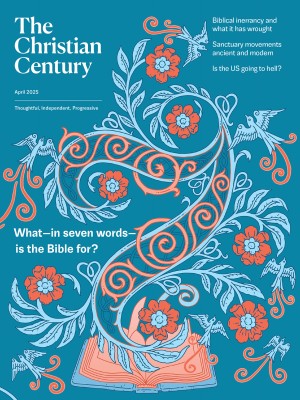The grace of identity
We tend to think of identity as either fixed or chosen. What if it’s bestowed and revealed, relational and dynamic?

Century illustration
How might Christians have a more truly theological conversation about identity? We could start with Jesus.
One thing we learn from Jesus’ resurrection body, as narrated in the gospels, is that there is genuine continuity with who he was before. Jesus is still incarnate: God’s purpose is still fundamentally to be with us in Christ. Jesus is still faithful to the disciples: He’s looking for intimate, restored, and transformative relationship. He still has wounds in his hands and side. But there’s also profound discontinuity: Jesus is no longer dead or subject to death. He can walk through walls and disappear from a wayside inn; he can ascend to heaven. Everything in the New Testament assumes that Jesus’ resurrected body shapes our hope for our own resurrection. So here’s a window into our ultimate identity, one of continuity with our earthly selves but also discontinuity. Is this perhaps the definitive theological word on identity? Our true and permanent identity is something that hasn’t yet fully come about.
Jesus’ transfiguration also reveals his true identity, which lies beyond conventional recognition. That identity emerges in relationship, in this case the historic location of Jesus in relation to Moses and Elijah—the law and the prophets—and the present location of Jesus in relation to Peter, James, and John, his current companions and the future leaders of the church. The shimmering light indicates that the disciples both have and have not yet recognized who Jesus is. Likewise, we both have and have not yet recognized who we are and who others are. Indeed, we each have an ultimate identity that only God knows, that even we cannot yet apprehend. Our identity is hidden with Christ in God.
Read our latest issue or browse back issues.
Compare these accounts of resurrection and transfiguration with two contemporary notions of identity. One is discovery. Discovery depicts identity as a fixed thing located or established in our past. Through a combination of conscientization, therapy, education, pilgrimage, and lived experience, we can trace our way back to our identity and come to inhabit it. Our discovered identity may contravene norms or disrupt expectations, but to be true to ourselves we must complete our quest and live into the consequences. Without freedom we can’t pursue our identity, and our integrity requires us to do so. This is a narrative that’s centered on the self—in isolation rather than in relationship.
A second contemporary way of understanding identity is construction. Construction appreciates that our identities are built out of allegiances, attractions, primal urges, formative cultures, and signature characteristics. Sculpting such dynamics into a single or multivalent identity, we continue to curate and refine our identity, often associating it with things we do or purchase or campaign for. While the first approach sees identity as given, this second model perceives it as chosen and made. It’s a thoroughly postmodern account: no identity is fixed. All is negotiable and fluid.
Resurrection and transfiguration affirm that identity is fundamentally bestowed and revealed. After all, while it’s too seldom acknowledged that none of us chooses to be born, it’s beyond dispute that resurrection is an act entirely of God’s grace rather than of our decision. Like the discovery approach, this sees identity as something we don’t get to choose—but in this case there is a choice, it’s just that it’s made by someone else. And there’s no simple equation that “we choose” equals freedom while “others choose” equals oppression, because sometimes being chosen is best of all.
The moment that crystallizes this sense of bestowal is baptism. Baptism preserves the dynamic character of identity, because it doesn’t conceive of identity as something fixed, static, and locked as a given in the past, the way (to take one example) essentialist renderings of male and female gender do. Instead, it allows for an emerging sense of vocation to shape who we each come to be.
At baptism, God says, I made you this way because I wanted one like you—but that doesn’t mean we yet know the full extent of what’s entailed by “this way.” And because baptism is grace, the identity it confers is not something we can construct. Instead, the initiative and principal direction derive from the Holy Spirit, and we find freedom in resting in that direction rather than resisting it.
Resurrection also reshapes our notion of identity by affirming that identity emerges in relationship. The gospel accounts of resurrection and transfiguration are about identity revealed through relationship. Who Jesus is becomes apparent as he interacts with Moses and Elijah and with Peter, James, and John, with Mary Magdalene and the disciples en route to Emmaus and the eleven in the upper room. My identity isn’t a possession I own; it’s something that becomes apparent in relationship to others—to other disciples, to the stranger, to the nonhuman creation, and to God.
In other words, identity is fundamentally about belonging. The moment that crystallizes both identity’s dynamism and its emergence in relationship is the Eucharist. The Eucharist is where God’s story, a neighborhood’s story, the church’s story, and a congregation’s story converge and coalesce. The term for the permanent experience of the Eucharist in establishing the identity of participants yesterday, today, forever, and across all places is the communion of saints.
The communion of saints celebrates how God has created each of us for a purpose, one we cannot fulfill without each other; how God loves us all equally yet loves each one of us as if we were the only one. The communion of saints transforms our notion of identity by turning our attention from ourselves to God, from who we uniquely are to what God is creatively making us, from where we are coming from to where we are going, from where we are restless to where we find our rest in God, from our endless quest to define our identity to inhabiting the dynamic identity we’re given as children of God.
Identity is not about the isolation of establishing that there is no one else on earth like me. It’s about the solidarity of believing there is a role for each one of us in the body of Christ.







